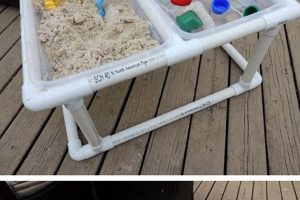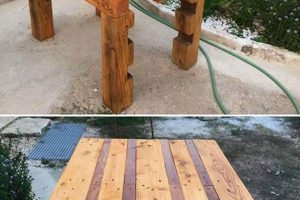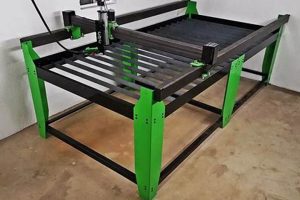The creation of furniture from repurposed automobile tires has gained popularity as a sustainable and cost-effective approach to home dcor. These projects often involve cleaning, reinforcing, and embellishing used tires to transform them into functional and aesthetically pleasing items. An example involves stacking two tires, securing them together, and adding a circular wooden or glass top to form a side table.
Repurposing these discarded items reduces environmental waste by diverting them from landfills or incineration. Furthermore, it offers an economical alternative to purchasing new furniture, particularly for individuals with budget constraints or those seeking unique, handcrafted pieces. Historically, repurposing discarded materials has been a common practice driven by necessity and resourcefulness, evolving into a conscious effort towards sustainability.
The following sections will delve into the practical aspects of constructing a durable and visually appealing piece from a recycled tire, exploring the necessary materials, step-by-step assembly instructions, and various customization options to suit individual preferences and interior design styles.
Construction Tips for Tire-Based Tables
The successful fabrication of a durable and aesthetically pleasing table from a discarded tire requires careful planning and execution. The following tips offer guidance for achieving optimal results throughout the construction process.
Tip 1: Prioritize Thorough Cleaning and Preparation: Remove all dirt, debris, and residue from the tire’s surface using a stiff brush and a suitable cleaning solution. Degreasing is critical for proper adhesion of paints or sealants. Allow ample drying time before proceeding.
Tip 2: Reinforce the Tire Structure: Consider adding internal support structures, such as wooden rings or metal bands, to enhance the tire’s stability and weight-bearing capacity. This is particularly important for tables intended to support heavier objects.
Tip 3: Select Appropriate Fasteners and Adhesives: Choose fasteners and adhesives that are compatible with both the tire material (rubber) and any additional materials used, such as wood, metal, or fabric. Ensure adequate holding strength for long-term durability.
Tip 4: Employ Proper Cutting Techniques: If modifications to the tire’s shape are required, use appropriate cutting tools, such as a utility knife or jigsaw with a rubber-cutting blade. Exercise caution and wear safety gear to prevent injury.
Tip 5: Apply Multiple Coats of Protective Finish: Enhance the tire’s resistance to wear, weather, and UV damage by applying several layers of sealant, paint, or varnish. Allow each coat to dry completely before applying the next.
Tip 6: Ensure a Secure Tabletop Attachment: If using a separate tabletop material (e.g., glass, wood), employ a robust method for securing it to the tire base. Options include screws, adhesives, or custom-fitted brackets. Verify stability before use.
Tip 7: Consider the Overall Design and Aesthetics: Plan the table’s color scheme, texture, and embellishments to complement the surrounding environment. Explore various decorative techniques, such as wrapping the tire with rope, fabric, or incorporating mosaic tiles.
By adhering to these guidelines, it is possible to transform a discarded tire into a functional and visually appealing table, contributing to both sustainable practices and personalized home decor.
The subsequent section will explore design ideas and inspirational concepts to stimulate creative approaches to the transformation process.
1. Tire selection.
The initial step in crafting a repurposed tire table is the selection of a suitable tire. This choice significantly influences the final product’s dimensions, aesthetic, and structural stability. Therefore, careful consideration of tire characteristics is paramount.
- Size and Diameter
The tire’s diameter determines the table’s overall height and footprint. Larger tires will naturally result in taller and wider tables, while smaller tires are suitable for side tables or smaller accent pieces. The intended use case dictates the optimal size. For example, a coffee table necessitates a larger diameter than a bedside table.
- Tire Type and Tread Pattern
Different tire types (e.g., passenger car, truck, off-road) exhibit varying tread patterns and sidewall designs. The tread pattern can contribute to the table’s visual texture. Aggressive off-road tire treads offer a rugged aesthetic, while smoother passenger car tires provide a more subtle appearance. Sidewall markings and lettering can also influence the overall design, requiring careful consideration during the cleaning and finishing stages.
- Tire Condition
While minor imperfections may be acceptable, the tire’s structural integrity is critical. Avoid tires with significant sidewall damage, deep cuts, or internal structural compromises. These defects can compromise the table’s stability and safety. Inspect the tire thoroughly for any signs of deterioration before proceeding.
- Availability and Cost
Tire availability varies depending on location and access to tire retailers or recycling centers. Sourcing tires at minimal or no cost is desirable for cost-effectiveness. However, prioritizing condition and suitability over price is essential to ensure a safe and aesthetically pleasing final product.
In summary, tire selection is not merely a practical consideration but a fundamental design choice. The size, type, condition, and availability of the tire collectively determine the possibilities and limitations of the repurposed table project. A well-chosen tire provides a solid foundation for a durable and visually appealing piece of furniture.
2. Cleaning protocols.
The successful creation of a durable and aesthetically pleasing table from a repurposed tire necessitates rigorous adherence to established cleaning protocols. Tire surfaces accumulate a diverse range of contaminants, including road grime, oil residues, brake dust, and environmental pollutants. The presence of these substances impedes the effective adhesion of paints, sealants, and other finishing materials, potentially compromising the structural integrity and visual appeal of the final product. Inadequate cleaning can lead to premature degradation of applied finishes, resulting in peeling, cracking, or discoloration over time. For example, if oil residues are not thoroughly removed prior to painting, the paint may not bond correctly, resulting in an uneven and easily damaged surface.
Effective cleaning protocols involve a multi-stage process. Initially, a dry brushing or vacuuming step removes loose debris and surface dirt. Subsequently, a degreasing agent specifically designed for rubber surfaces is applied to dissolve and emulsify oil-based contaminants. This is followed by a thorough rinsing with water to remove the degreasing agent and loosened grime. In cases of persistent staining or stubborn residues, a mild abrasive cleaner may be employed, but caution must be exercised to avoid damaging the tire’s surface. Allowing adequate drying time after cleaning is crucial to ensure optimal adhesion of subsequent coatings.
In conclusion, cleaning protocols represent a critical, often overlooked, element in the construction of a repurposed tire table. Proper execution of these protocols ensures the longevity and aesthetic quality of the finished product by promoting optimal adhesion of finishing materials and preventing premature degradation. Disregarding these procedures can lead to suboptimal results and ultimately undermine the sustainability and value of the project.
3. Structural integrity.
The term “structural integrity” assumes paramount importance in the context of repurposed tire furniture. A tire, initially designed to withstand the dynamic loads of vehicular use, must be appropriately modified and reinforced to ensure its suitability as a load-bearing component in a table. Failure to address this aspect can result in instability, collapse, and potential injury.
- Internal Reinforcement
The hollow nature of a tire necessitates internal reinforcement to prevent deformation under load. This can be achieved through the insertion of wooden or metal rings, rigid foam inserts, or the application of expanding foam. These materials provide support and maintain the tire’s shape, distributing weight more evenly and preventing localized stress concentrations. For example, a wooden ring fitted snugly within the tire’s inner circumference significantly increases its resistance to buckling under vertical pressure.
- Tabletop Attachment Stability
The method of attaching the tabletop to the tire base directly influences the overall stability of the structure. Simple adhesive bonding may prove insufficient for heavier tabletops or frequent use. Mechanical fasteners, such as screws or bolts, provide a more secure and reliable connection. Distributing these fasteners evenly around the perimeter of the tire ensures uniform load transfer and minimizes the risk of detachment. Furthermore, the use of a robust mounting plate between the tire and tabletop provides a larger surface area for attachment and enhances stability.
- Material Compatibility and Adhesion
The selection of adhesives, coatings, and other materials must consider their compatibility with the tire’s rubber composition. Incompatible materials may exhibit poor adhesion, leading to delamination or weakening of the structure over time. Surface preparation, such as thorough cleaning and abrasion, is crucial to promote adequate adhesion. The use of primers specifically designed for rubber surfaces can further enhance bond strength and durability.
- Weight Distribution and Base Stability
The overall design of the table must consider weight distribution to ensure stability. A wider base or the addition of stabilizing feet can prevent tipping, particularly when the table is placed on uneven surfaces. Filling the tire with a dense material, such as sand or gravel, can lower the center of gravity and further enhance stability. The location of the tabletop relative to the tire base also influences stability; a larger tabletop overhang increases the risk of tipping.
In summary, structural integrity is not merely a cosmetic consideration but a fundamental requirement for the safe and functional use of repurposed tire tables. Internal reinforcement, secure tabletop attachment, material compatibility, and weight distribution are all critical factors that must be carefully addressed to ensure a durable and stable final product.
4. Tabletop materials.
The selection of materials for the tabletop component is a critical determinant of the overall functionality, aesthetic appeal, and durability of a repurposed tire table. This choice directly impacts the table’s suitability for various applications and influences its integration into different interior design schemes. The inherent properties of the chosen material dictate its resistance to wear, susceptibility to damage, and ease of maintenance. For example, a glass tabletop offers a sleek, modern aesthetic and is relatively easy to clean, but it is also prone to scratching and shattering under impact. Conversely, a solid wood tabletop provides a robust and durable surface, but it requires regular sealing and is susceptible to water damage if not properly maintained.
The practical significance of understanding the relationship between tabletop materials and the overall “diy tire table” lies in the ability to tailor the design to specific needs and preferences. A high-traffic area, such as a living room, might benefit from a tabletop constructed from a resilient material like reclaimed wood or a composite material, capable of withstanding frequent use and potential spills. Alternatively, a decorative table in a low-traffic setting could utilize more delicate materials, such as glass or mosaic tiles, to enhance its visual appeal without compromising its functionality. The attachment method also hinges on the material selected; heavier materials may necessitate more robust fastening systems to ensure structural integrity. For instance, a thick concrete tabletop would require heavy-duty bolts or a custom-fabricated metal frame for secure attachment to the tire base.
In conclusion, the selection of tabletop materials represents a crucial design decision that directly influences the form and function of a repurposed tire table. A thorough understanding of material properties, combined with careful consideration of the table’s intended use and aesthetic context, is essential for creating a durable, visually appealing, and practically functional piece of furniture. While challenges may arise in sourcing suitable materials or adapting attachment methods, the resulting product offers a unique blend of sustainability, resourcefulness, and personalized design.
5. Attachment methods.
The structural stability and overall longevity of a repurposed tire table are inextricably linked to the employed attachment methods. The means by which the tabletop is affixed to the tire base directly influence the table’s ability to withstand weight, resist movement, and maintain its form over time. The selection and implementation of appropriate attachment techniques are therefore paramount to the successful construction of a functional and durable piece of furniture.
- Mechanical Fasteners (Screws, Bolts)
Mechanical fasteners provide a direct and robust connection between the tabletop and the tire. Screws and bolts, when properly sized and installed, create a physical interlock that resists separation. The effectiveness of these fasteners depends on several factors, including the type of screw or bolt, the material into which they are inserted (requiring pilot holes in harder materials), and the distribution of fasteners around the perimeter of the tabletop. For instance, using coarse-threaded screws in wood and distributing them evenly provides a stronger connection than using fine-threaded screws spaced sparsely.
- Adhesive Bonding
Adhesive bonding relies on the chemical interaction between the adhesive and the surfaces being joined. The selection of an appropriate adhesive is crucial, as not all adhesives are compatible with both rubber and tabletop materials (e.g., wood, glass, metal). Surface preparation, such as cleaning and abrasion, is also essential to ensure optimal adhesion. While adhesives can provide a clean and aesthetically pleasing connection, they may be less resistant to shear forces and long-term stress compared to mechanical fasteners. An example is using a two-part epoxy specifically formulated for bonding rubber to wood; this adhesive offers greater strength than general-purpose glue but still may not suffice for heavy loads.
- Hybrid Methods (Mechanical Fasteners & Adhesive)
Combining mechanical fasteners with adhesive bonding can leverage the strengths of both approaches. The mechanical fasteners provide immediate and reliable holding power, while the adhesive fills gaps, distributes stress, and provides additional resistance to separation. This hybrid approach is particularly beneficial for heavier tabletops or applications where high stability is required. For example, screws could be used to secure a wooden tabletop to the tire base, with adhesive filling the space between the two surfaces to enhance the bond and prevent wobbling.
- Custom Brackets and Mounting Systems
For more complex designs or heavier tabletops, custom-fabricated brackets or mounting systems may be necessary. These systems can be designed to distribute weight evenly, provide additional structural support, and facilitate easy assembly and disassembly. Custom brackets can be made from metal, wood, or other durable materials, and they can be attached to the tire base using screws, bolts, or welding. An example is a metal ring that conforms to the inner diameter of the tire, with tabs that extend outward to support and secure the tabletop.
The choice of attachment method is a critical decision in the “diy tire table” construction process. Considerations must include the tabletop material, the intended use of the table, and the desired level of stability and durability. Combining various techniques can result in a robust and aesthetically pleasing final product.
6. Aesthetic finishes.
Aesthetic finishes are crucial in transforming a repurposed tire from a discarded object into a desirable piece of furniture. The application of suitable finishes enhances visual appeal, provides protection against environmental elements, and allows for customization to complement existing decor. Without proper attention to aesthetic finishes, a project may lack refinement and fail to integrate seamlessly into its intended environment.
- Paint Selection and Application
The choice of paint significantly impacts the visual outcome of the project. Options range from spray paints for even coverage to acrylic paints for detailed designs. Primers are essential for proper adhesion to the rubber surface. Multiple coats may be required for optimal coverage and durability. Considerations include color selection to match existing decor and the application of clear coats for added protection against scratches and UV damage. For example, an automotive-grade paint could provide a durable and aesthetically pleasing finish.
- Textural Treatments
Beyond simple painting, textural treatments add depth and visual interest. These include wrapping the tire with rope or twine, applying mosaic tiles, or using textured paints to create a tactile surface. Rope wrapping, for instance, can evoke a nautical theme and provide a comfortable surface to touch. Mosaic tiles offer opportunities for intricate patterns and color combinations. Textured paints can mimic the appearance of stone or other natural materials. However, these treatments require careful planning and execution to ensure a cohesive and durable result.
- Sealing and Protection
Regardless of the chosen finish, sealing is crucial for protecting the underlying materials from moisture, UV radiation, and wear. Sealants can be applied over paint, rope, or other textural treatments to extend the lifespan of the project. Clear coats are commonly used to protect painted surfaces, while specialized sealants are available for protecting natural materials like rope from water damage. For instance, a marine-grade varnish could be applied to a rope-wrapped table to provide superior water resistance.
- Decorative Embellishments
Decorative embellishments provide opportunities to personalize the table and add unique visual elements. These can include stencils, decals, metal accents, or other decorative items that reflect individual style. Stencils can be used to create intricate patterns or monograms, while decals offer a quick and easy way to add visual interest. Metal accents, such as decorative tacks or studs, can enhance the table’s industrial aesthetic. The selection and placement of these embellishments should be carefully considered to ensure a cohesive and balanced design.
In summary, aesthetic finishes are integral to the transformation of a repurposed tire into a functional and attractive table. Paint selection, textural treatments, sealing, and decorative embellishments all contribute to the final visual outcome and durability of the project. Careful consideration of these elements allows for the creation of a unique and personalized piece of furniture that seamlessly integrates into its intended environment, showcasing both sustainability and design ingenuity.
7. Durability enhancement.
Durability enhancement is a crucial consideration in the creation of repurposed tire tables. While the inherent robustness of a tire offers a foundation for a functional piece of furniture, specific steps must be taken to ensure its longevity and resistance to environmental factors and daily wear. These enhancements directly impact the table’s lifespan, aesthetic appeal, and overall value.
- UV Protection and Sealants
Prolonged exposure to ultraviolet (UV) radiation can cause the rubber in tires to degrade, leading to cracking, fading, and a loss of structural integrity. Applying UV-resistant sealants or paints mitigates this damage, preserving the tire’s appearance and extending its lifespan. For example, marine-grade varnishes, specifically formulated to withstand harsh marine environments, offer excellent UV protection for tire tables used outdoors.
- Water Resistance and Waterproofing
Tire tables, particularly those used outdoors or in humid environments, are susceptible to water damage. Water can penetrate the rubber, causing it to swell, warp, and develop mold or mildew. Applying waterproof coatings or sealants creates a barrier against moisture, preventing these problems. Examples include rubberized coatings or epoxy resins that create a seamless, waterproof seal.
- Reinforcement and Stabilization
To enhance the table’s structural integrity and prevent deformation under load, reinforcement techniques are often employed. This may involve filling the tire with concrete or other dense materials, adding internal supports made of wood or metal, or wrapping the tire with rope or fabric for added strength. These methods improve the table’s stability and weight-bearing capacity, making it more durable and functional.
- Abrasion Resistance and Protective Coatings
Surface abrasion from daily use can gradually wear down the tire’s surface, leading to cosmetic damage and potential structural weakening. Applying abrasion-resistant coatings, such as polyurethane or epoxy resins, protects the tire from scratches, scuffs, and other forms of wear. These coatings create a durable, easy-to-clean surface that enhances the table’s longevity and aesthetic appeal. For instance, applying a clear coat of polyurethane over a painted tire table provides a protective layer that resists scratches and makes cleaning easier.
The implementation of these durability enhancement strategies is integral to the successful creation of a repurposed tire table. By protecting the tire from UV radiation, water damage, abrasion, and structural stress, it is possible to transform a discarded tire into a long-lasting, aesthetically pleasing, and functional piece of furniture, thereby contributing to both environmental sustainability and creative design.
Frequently Asked Questions
This section addresses common inquiries regarding the construction, durability, and safety aspects of creating tables from repurposed tires.
Question 1: Is the use of recycled tires in furniture construction environmentally sound?
Repurposing tires diverts them from landfills, reducing waste and conserving resources. However, the process should minimize the use of harmful chemicals and prioritize sustainable materials.
Question 2: What are the potential safety hazards associated with working with used tires?
Used tires may contain embedded debris, sharp objects, and potentially hazardous materials. Appropriate protective gear, including gloves and eye protection, must be worn during handling and modification.
Question 3: How can the odor commonly associated with used tires be mitigated?
Thorough cleaning with specialized degreasers and allowing ample ventilation during the drying process can significantly reduce tire odor. Sealing the tire with appropriate coatings can further minimize odor emission.
Question 4: What is the optimal method for ensuring the structural stability of a tire table?
Internal reinforcement with wood, metal, or rigid foam is essential for preventing deformation and ensuring load-bearing capacity. Secure attachment of the tabletop to the tire base is also critical for stability.
Question 5: How can the durability of a tire table be maximized for outdoor use?
Application of UV-resistant sealants and waterproof coatings is necessary to protect the tire from degradation and prevent water damage. Regular maintenance and cleaning are also crucial for longevity.
Question 6: Are there any regulations or restrictions regarding the use of recycled tires in furniture construction?
Local regulations may vary regarding the use and disposal of tires. It is advisable to consult local authorities to ensure compliance with environmental standards and building codes.
In summary, the successful creation of a repurposed tire table requires careful attention to safety, environmental considerations, and structural integrity. Proper planning and execution can result in a durable and aesthetically pleasing piece of furniture.
The following section will provide guidance on troubleshooting common issues encountered during the construction process.
Conclusion
This exploration of the “diy tire table” concept underscores its potential as a sustainable and resourceful approach to furniture creation. Success hinges on meticulous preparation, robust construction techniques, and informed material selection. Attention to detail in cleaning, reinforcing, and finishing is paramount for achieving a durable and aesthetically pleasing final product.
The transformation of discarded tires into functional furniture exemplifies responsible resource management. Continued innovation in design and refinement of construction methods will further enhance the viability and appeal of the “diy tire table” as a mainstream furniture option, offering both environmental benefits and opportunities for creative expression.







